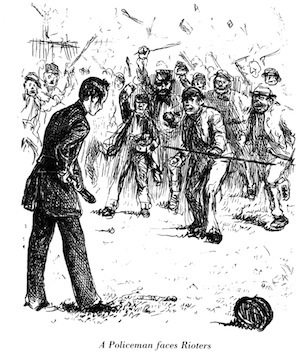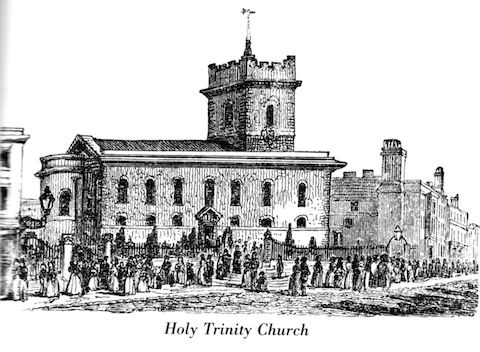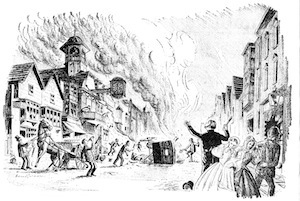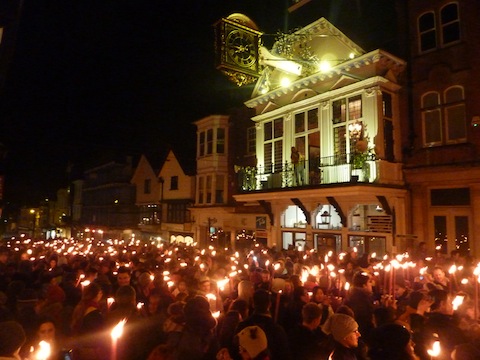 Abraham Lincoln
If given the truth, the people can be depended upon to meet any national crisis...
Abraham Lincoln
If given the truth, the people can be depended upon to meet any national crisis...
 Guildford news...
for Guildford people, brought to you by Guildford reporters - Guildford's own news service
Guildford news...
for Guildford people, brought to you by Guildford reporters - Guildford's own news service
Reason Why Guildford Remembers The 5th Of November
Published on: 21 Oct, 2013
Updated on: 21 Oct, 2013
With Bonfire Night fast approaching, Victoria Lazarevic takes a look at a reign of terror by the Guildford Guys in the mid-19th century.
A reign of terror on Bonfire Night, by rioting mobs of youths who carried out violent assaults and vandalism on the streets of Guildford, reached its peak in the 1850s.

A policeman faces the mob during one of the Guildford Guy riots. Gavin Morgan’s book The Guildford Guys is well worth checking out.
The Guildford Guys were a secret bonfire society. They were born from a call that encouraged the people of Britain not to forget, but to ensure they commemorated Guy Fawkes’ failed attempt to burn down the Houses of Parliament in 1605. Unfortunately, many of those who rallied to the call to remember the Gunpowder Plot soon turned their celebrations into boisterous and often violent behaviour.
The ‘Guys’, wearing outlandish costumes and masks, gathered outside the town carrying clubs studded with hobnails, lighted torches and bundles of wood.
They would march into Guildford like an invading army and light a bonfire outside Holy Trinity Church (currently celebrating its 250th anniversary), in the High Street.
Guildford Dragon NEWS contributor and local historian David Rose says the mobs used Bonfire Night to “come out of the darkness,” their “faces blackened and wearing disguises”. He adds: “To fuel their bonfires the mob ripped down fences and damaged property in order to get their hands on anything to burn.”
Law and order not as it is today, the Bonfire Night violent revelling continued for several years.
The mob was so out of control, it is said that Guildford’s police sergeant at the time used to lock his constables in the police station for their own safety.
News spread nationally and The Times ran a story of the Guildford Guys’ behaviour. Yet it took the might of the army to begin to bring the riots to a close. In 1863, under the command of a Lt Grey, 150 men of the 37th Foot and 50 men of the 1st Royal Dragoons, were dispatched. It seems they did the trick and the mob dispersed.
But once the soldiers left the mob did return on November 18. Among the 151 special constables that had been sworn in, a policeman was badly beaten up. But it seems that with better overall policing and better discipline, the Guys’ days were numbered.
Such is the significance of the Guildford Guys to local history, a plans for a sculpture of a large a circular dome-like bonfire, made of metal rods representing a raging fire was unveiled last year. Its theme not only to recall the acts of violence in Guildford but also to commemorate the law and order which was restored. The structure did not pass Guildford Borough Council’s planners. Although there was a good deal of support for it, there was an equal amount of opposition. Click here to see a previous story about the bonfire sculpture.
A peaceful, safe and official celebration of the anniversary of bonfire night on November 5 in Guildford this year comes in the form of the Fireworks Fiesta at Stoke Park organised by the Guildford Lions. The anniversary event begins less in the spirit of an invading army: instead as a procession of people carrying lighted torches from the High Street and along London Road to Stoke Park and, and then a fantastic fireworks display.
Responses to Reason Why Guildford Remembers The 5th Of November
Leave a Comment Cancel replyPlease see our comments policy. All comments are moderated and may take time to appear.
Recent Articles
- Guildford Institute’s Crowdfunding Project for Accessible Toilet in its New Community and Wellbeing Centre
- Letter: Guildford – Another Opportunity Missed?
- Letter: GBC’s Corporate Strategy – Where Is the Ambition?
- My Memories of John Mayall at a Ground-breaking Gig in Guildford Nearly Six Decades Ago
- Westborough HMO Plans ‘Losing the Heart of the Street’ Says Resident
- College Invests to Boost Surrey’s Economy and Close Digital Skills Gap
- Community Lottery Brings Big Wins for Local Charities
- GBC Housing Plan Promises ‘A Vibrant Urban Neighbourhood’ Near Town Centre
- Hospital Pillows ‘Shortage’ at the Royal Surrey
- Updated: Caravans Set Up Camp at Ash Manor School


Recent Comments
- Ian Macpherson on Updated: Main Guildford to Godalming Road Closed Until August 1
- Sara Tokunaga on GBC Housing Plan Promises ‘A Vibrant Urban Neighbourhood’ Near Town Centre
- Michael Courtnage on Daily Mail Online Reports Guildford Has Highest-paid Council Officer
- Alan Judge on GBC Housing Plan Promises ‘A Vibrant Urban Neighbourhood’ Near Town Centre
- John Perkins on GBC Housing Plan Promises ‘A Vibrant Urban Neighbourhood’ Near Town Centre
- S Collins on GBC Housing Plan Promises ‘A Vibrant Urban Neighbourhood’ Near Town Centre
Search in Site
Media Gallery
Dragon Interview: Local Artist Leaves Her Mark At One of England’s Most Historic Buildings
January 21, 2023 / No Comment / Read MoreDragon Interview: Lib Dem Planning Chair: ‘Current Policy Doesn’t Work for Local People’
January 19, 2023 / No Comment / Read MoreA3 Tunnel in Guildford ‘Necessary’ for New Homes, Says Guildford’s MP
January 10, 2023 / No Comment / Read More‘Madness’ for London Road Scheme to Go Ahead Against ‘Huge Opposition’, Says SCC Leader
January 6, 2023 / No Comment / Read MoreCouncillor’s Son Starts Campaign for More Consultation on North Street Plan
December 30, 2022 / No Comment / Read MoreCounty Council Climbs Down Over London Road Works – Further ‘Engagement’ Period Announced
December 14, 2022 / No Comment / Read MoreDragon Interview: GBC Reaction to the Government’s Expected Decision to Relax Housing Targets
December 7, 2022 / No Comment / Read MoreHow Can Our Town Centre Businesses Recover? Watch the Shop Front Debate
May 18, 2020 / No Comment / Read More












Andrew Backhurst
October 22, 2013 at 10:38 pm
The people of Guildford will not have rioted for no reason, in those day’s you could have been deported for stealing a loaf of bread. Guildford at the time was an agricultural town, not like the industrial northern satanic mill towns.
The railway had just arrived and with it no doubt lots of newcomers with wealth from London. This riot wasn’t a one off it happened for years. Social problems must have been at the heart of it and tearing down and burning the wooden stand from the Guildford racecourse will have been a swipe at the rich.